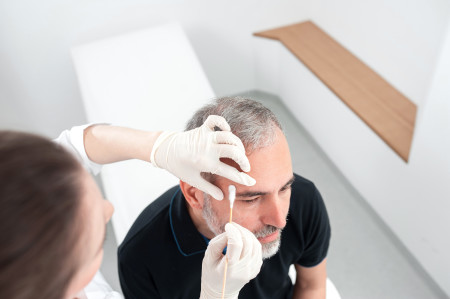Molluscum contagiosum: Who gets and causes
Common in kids
The people most likely to get molluscum contagiosum are healthy children who are 1 to 10 years old.

What causes molluscum contagiosum?
A virus called molluscum contagiosum causes this skin infection.
How do people get the virus?
People catch molluscum contagiosum when they get the virus on their skin. This can happen by:
Having skin-to-skin contact with someone who has molluscum.
Touching an object that someone who has molluscum touched.
Sharing a personal item, such as clothing or a towel, with someone who has molluscum.
Who has the highest risk of getting molluscum contagiosum?
While anyone can get molluscum contagiosum, some people are more likely to catch it. Medical records indicate that the following individuals are most susceptible:
Children who are 1 to 10 years old, especially if they have eczema
Athletes who have skin-to-skin contact or share equipment
People who are sexually active
Anyone who has trouble fighting off infections
Those who live in a warm, humid area and have close contact with others
It’s believed that children who are 1 to 10 years old are most likely to get this skin infection because they have the most skin-to-skin contact. They seem especially vulnerable if they have eczema. The extremely dry, cracked skin of eczema may make it easier for the virus to infect the skin.
Teens and adults can also get molluscum contagiosum. Usually, they get it during sexual contact. When this happens, molluscum is considered a sexually transmitted infection (STI). When someone gets molluscum through sexual contact, bumps usually develop on (and around) the genitals. Sometimes, bumps also develop inside the mouth.
Some need treatment
Anyone who has trouble fighting off infections usually needs treatment because the body cannot get rid of the virus on its own.

Anyone who has trouble fighting off an infection also has a higher risk. People who have a weakened immune system may get larger bumps on their skin. They may need treatment to get rid of the bumps.
You may have trouble fighting off infections if you are
Getting treated for cancer
Living with a transplanted organ
HIV-positive but not taking antiretroviral medication
Taking medication that weakens the immune system, such as methotrexate
Can you catch molluscum when someone sneezes or coughs?
No. The virus that causes molluscum contagiosum stays in the top layer of the skin.
Because it never gets inside the body, you cannot catch the virus when someone sneezes or coughs.
How does molluscum spread on your skin once you have it?
You can spread the virus from one part of your body to another by:
Touching, scratching, or picking at a molluscum bumps on your skin and then touching an area without molluscum
Shaving the bumps and using the same razor to shave an area without molluscum
Having electrolysis on skin with and without molluscum
When the virus spreads. you won’t see new bumps right away. The bumps usually appear 2 to 6 weeks later.
While the bumps will clear on their own if you have a healthy immune system, many people seek treatment to clear the bumps more quickly. Find out when dermatologist recommend treatment at: Molluscum contagiosum: Diagnosis, treatment, and outcome.
Images
Getty Images
References
Centers for Disease Control and Prevention (CDC). “Molluscum contagiosum: Risk factors.” Page last reviewed May 2015. Page last accessed March 22, 2019.
Daveluy S. “Poster 3782: High-definition optical coherence tomography as a noninvasive technique in the diagnosis and management of molluscum contagiosum.” J Am Acad Dermatol 2016;74(issue 5, suppl. 1):AB163. No commercial support identified.
Issacs SN. “Molluscum contagiosum” UptoDate. Last accessed March 25, 2019.
van der Wouden JC, van der Sande R, et al. “Cochrane Review: Interventions for cutaneous molluscum contagiosum.” Cochrane Database Syst Rev. 2017;5:CD004767.
Zancanaro PC, McGirt LY, et al. “Cutaneous manifestations of HIV in the era of highly active antiretroviral therapy: an institutional urban clinic experience.” J Am Acad Dermatol. 2006;54(4):581-8.
 Atopic dermatitis: More FDA-approved treatments
Atopic dermatitis: More FDA-approved treatments
 Biosimilars: 14 FAQs
Biosimilars: 14 FAQs
 How to trim your nails
How to trim your nails
 Relieve uncontrollably itchy skin
Relieve uncontrollably itchy skin
 Fade dark spots
Fade dark spots
 Untreatable razor bumps or acne?
Untreatable razor bumps or acne?
 Tattoo removal
Tattoo removal
 Scar treatment
Scar treatment
 Free materials to help raise skin cancer awareness
Free materials to help raise skin cancer awareness
 Dermatologist-approved lesson plans, activities you can use
Dermatologist-approved lesson plans, activities you can use
 Find a Dermatologist
Find a Dermatologist
 What is a dermatologist?
What is a dermatologist?